Numerical Simulation Study of Gas–Liquid–Solid Triphase Coupling in Fully Mechanized Excavation Faces with Variation in Dust Source Points
Abstract
:1. Introduction
2. Mathematical Model
3. Geometric Model
3.1. Model Construction
3.2. Grid Division
4. Boundary Conditions and Model Parameter Setting
5. Results and Analysis of Gas–Liquid–Solid Three-Phase Coupling at Fully Mechanized Excavation Face
5.1. Analysis of Simulation Results of Roadway Air Flow Field
5.2. Analysis of Simulation Results of Airflow and Dust Field
5.3. Analysis of Simulation Results of Dust–Fog Coupling Field
6. Field Measurement and Application of Dust Concentration in Excavating Face
6.1. Measuring Method and Measuring Point Arrangement
6.2. Dust Concentration Measured on Site
6.3. Comparison between Numerical Simulation Results and Measured Data
7. Conclusions
- (1)
- Using the long-pressure and short-suction ventilation method significantly influences dust suppression and collection. The movement characteristics of the air flow can be divided into three areas, namely vortex area, jet area and backflow area. The distribution pattern of the dust field is significantly influenced by changes in dust source points under the action of airflow. Dust source points 1 and 2 are located lower on the cutting face, where the airflow velocity is lower, and the excavator body hinders dust diffusion. This results in higher dust concentrations at the mining driver’s position and the return air side. The dust concentration at dust source point 2 is lower than that at dust source point 1. Conversely, dust source points 3 and 4 are located higher on the cutting face, where increased airflow velocity is higher, and the excavator body hinders dust diffusion, resulting in relatively lower dust concentrations. Dust source point 5 is most affected by airflow and the exhaust duct, benefiting from dust removal of the long-pressure and short-suction ventilation method. Simulations show that when water mist is applied to dust source point 1, dust and mist droplet concentrations decrease with distance. By t = 60 s, most of the dust and mist droplets are captured. Only a small portion of dust remains, moving irregularly in a vortex owing to the absence of airflow, before eventually settling down and being captured by the exhaust duct.
- (2)
- By comparing the field data and numerical simulation results, the variation trends in the on-site measurement and simulation results of dust concentration along the fully mechanized tunneling roadway are similar and correlated. This further verifies the accuracy of the simulation results and provides certain guidance for the practical application of water mist on site, thus effectively improving the underground working environment of coal mines, ensuring the health of workers, and further promoting the sustainable development of the coal industry.
- (3)
- This paper focuses on two factors affecting dust diffusion: water mist and dust source points, but does not analyze factors such as air leakage from air ducts. Therefore, the factors affecting dust distribution should be comprehensively considered and further studied in future research.
Author Contributions
Funding
Institutional Review Board Statement
Informed Consent Statement
Data Availability Statement
Conflicts of Interest
References
- Zhou, G.; Duan, J.; Sun, B.; Jing, B.; Kong, Y.; Zhang, Y.; Ni, G.; Sun, L. Numerical Simulation of Dust Migration Law at Fully Mechanized Excavation Face of Rock Roadway with Forced Ventilation Based on DPM. Saf. Coal Mines 2016, 47, 190–193. [Google Scholar]
- Zheng, L.; Li, D.; Song, S.; Wang, H.; Sui, J. Study on the regional atomized dust suppression technological system based on the measured law of dust concentration distribution in longwall fully mechanized mining faces. Environ. Dev. Sustain. 2021, 24, 3110–3125. [Google Scholar] [CrossRef]
- Wu, B.; Yu, Z.; Zhou, Y.; Guo, Z.; Jiang, Z. Reasonable Selection of Dusting Method and Its Application in Changcun Comprehensive Drivaging Face. Saf. Environ. Eng. 2014, 21, 98–103. [Google Scholar]
- Huang, L. Study on dust control technology of fully mechanized driving face in hard-to-wet and outburst. J. Appl. Sci. Eng. Innov. 2020, 7, 201–205. [Google Scholar]
- Li, Z.; Ma, S.; Zhang, H. Study on Dust Distribution Rule Affected by Dust Source in Fully Mechanized Heading Face. Coal Sci. Technol. 2020, 39, 136–139. [Google Scholar]
- Hu, S.; Liao, Q.; Feng, G.; Huang, Y.; Shao, H.; Fan, Y.; Ye, Y. Numerical study of gas-solid two-phase flow around road-header drivers in a fully mechanized excavation face. Powder Technol. 2018, 344, 959–969. [Google Scholar]
- Yin, W.; Zhou, G.; Gao, D. Simulation analysis and engineering application of distribution characteristics about multi-stage atomization field for cutting dust in fully mechanized mining face. Adv. Powder Technol. 2019, 30, 2600–2615. [Google Scholar]
- Heng, Z. Study on Dust Distribution Rule Affected by Dust Source and Dust Reduction Measures in Fully Mechanized Heading Face. Bachelor’s Thesis, Xi’an University of Science and Technology, Xi’an, China, 2019. [Google Scholar]
- Yang, Z.; Wang, Y. Numerical simulation of dust and spray coupling under wet dust removal condition in fully mechanized excavation face. Saf. Coal Mines 2021, 52, 170–175. [Google Scholar]
- Nie, W.; Liu, F.; Xu, C.; Peng, H.; Zhang, H.; Mwabaima, F.I. Study on the optimal parameter range of droplet-wrapped respirable dust in spray dust fall by mesoscopic method. Environ. Res. 2022, 214, 114035. [Google Scholar] [CrossRef]
- Wang, X. Study on Characteristics and Numerical Simulation of Spray Atomization in Underground Coal Mines. Bachelor’s Thesis, Anhui University of Science and Technology, Chuzhou, China, 2020. [Google Scholar]
- Zhao, B.; Xiao, P.; Li, S.; Liu, X.; Lin, H.; Yan, D.; Chen, Z.; Chen, L. Study on the influence pattern and efficiency enhanced mechanism of acoustic-chemical spray dust reduction. Sci. Total Environ. 2023, 900, 165913. [Google Scholar] [CrossRef]
- Hao, T.; Wang, L.; Wang, Z.; Li, F.; Jiang, W.; Jiang, S. Research on Dust Migration and Dust Deposition Rules of Breathing Zone in Fully Mechanized Mining Face. ACS Omega 2023, 8, 39143–39153. [Google Scholar] [CrossRef]
- Gong, X.; Zhao, X.; Yang, F.; Liu, H.; Feng, X.; Song, T.; Chen, F. Wind flow control for optimization of dust field distribution under. Coal Eng. 2021, 53, 122–126. [Google Scholar]
- Zhang, Y.; Xu, X.; Jiang, W.; Yao, L. Wan Influence of dust source location in fully-mechanized excavation face on location of negative pressure suction opening. J. China Saf. Sci. 2021, 31, 147–155. [Google Scholar]
- Chang, P.; Xu, G.; Zhou, F.; Mullins, B.; Abishek, S.; Chalmers, D. Minimizing DPM pollution in an underground mine by optimizing auxiliary ventilation systems using CFD. Tunn. Undergr. Space Technol. Inc. Trenchless Technol. Res. 2019, 87, 112–121. [Google Scholar] [CrossRef]
- Chen, L.; Liu, G. Airflow-Dust Migration Law and Control Technology Under the Simultaneous Operations of Shotcreting and Drilling in Roadways. Arab. J. Sci. Eng. 2019, 44, 4961–4969. [Google Scholar] [CrossRef]
- Jiang, W.; Xu, X.; Wen, Z.; Wei, L. Applying the similarity theory to model dust dispersion during coal-mine tunneling. Process Saf. Environ. Prot. 2021, 148, 415–427. [Google Scholar] [CrossRef]
- Jing, D.; Jia, X.; Ge, S.; Zhang, T.; Ma, M. Numerical simulation and experimental study of vortex blowing suction dust control in a coal yard with multiple dust production points. Powder Technol. 2021, 388, 554–565. [Google Scholar] [CrossRef]
- Ren, T.; Wang, Z.; Cooper, G. CFD modelling of ventilation and dust flow behaviour above an underground bin and the design of an innovative dust mitigation system. Tunn. Undergr. Space Technol. Inc. Trenchless Technol. Res. 2014, 41, 241–254. [Google Scholar] [CrossRef]
- Xia, Y.; Yang, D.; Hu, C.; Wu, C.; Han, J. Numerical simulation of ventilation and dust suppression system for open-type TBM tunneling work area. Tunn. Undergr. Space Technol. Inc. Trenchless Technol. Res. 2016, 56, 70–78. [Google Scholar] [CrossRef]
- Xiu, Z.; Nie, W.; Chen, D.; Yan, J.; Cai, P.; Liu, Q.; Wei, C. Numerical simulation study on the coupling mechanism of composite-source airflow–dust field in a fully mechanized caving face. Powder Technol. 2019, 356, 443–457. [Google Scholar] [CrossRef]
- Zhou, G.; Feng, B.; Yin, W.; Wang, J. Numerical simulations on airflow-dust diffusion rules with the use of coal cutter dust removal fans and related engineering applications in a fully-mechanized coal mining face. Powder Technol. 2018, 339, 354–367. [Google Scholar] [CrossRef]
- Zhou, G.; Zhang, Q.; Hu, Y.; Gao, D.; Wang, S.; Sun, B. Dust removal effect of negatively-pressured spraying collector for advancing support in fully mechanized coal mining face: Numerical simulation and engineering application. Tunn. Undergr. Space Technol. Inc. Trenchless Technol. Res. 2020, 95, 103149. [Google Scholar] [CrossRef]
- Zhang, Q.; Zhou, G.; Qian, X.; Yuan, M.; Sun, Y.; Wang, D. Diffuse pollution characteristics of respirable dust in fully-mechanized mining face under various velocities based on CFD investigation. J. Clean. Prod. 2018, 184, 239–250. [Google Scholar] [CrossRef]

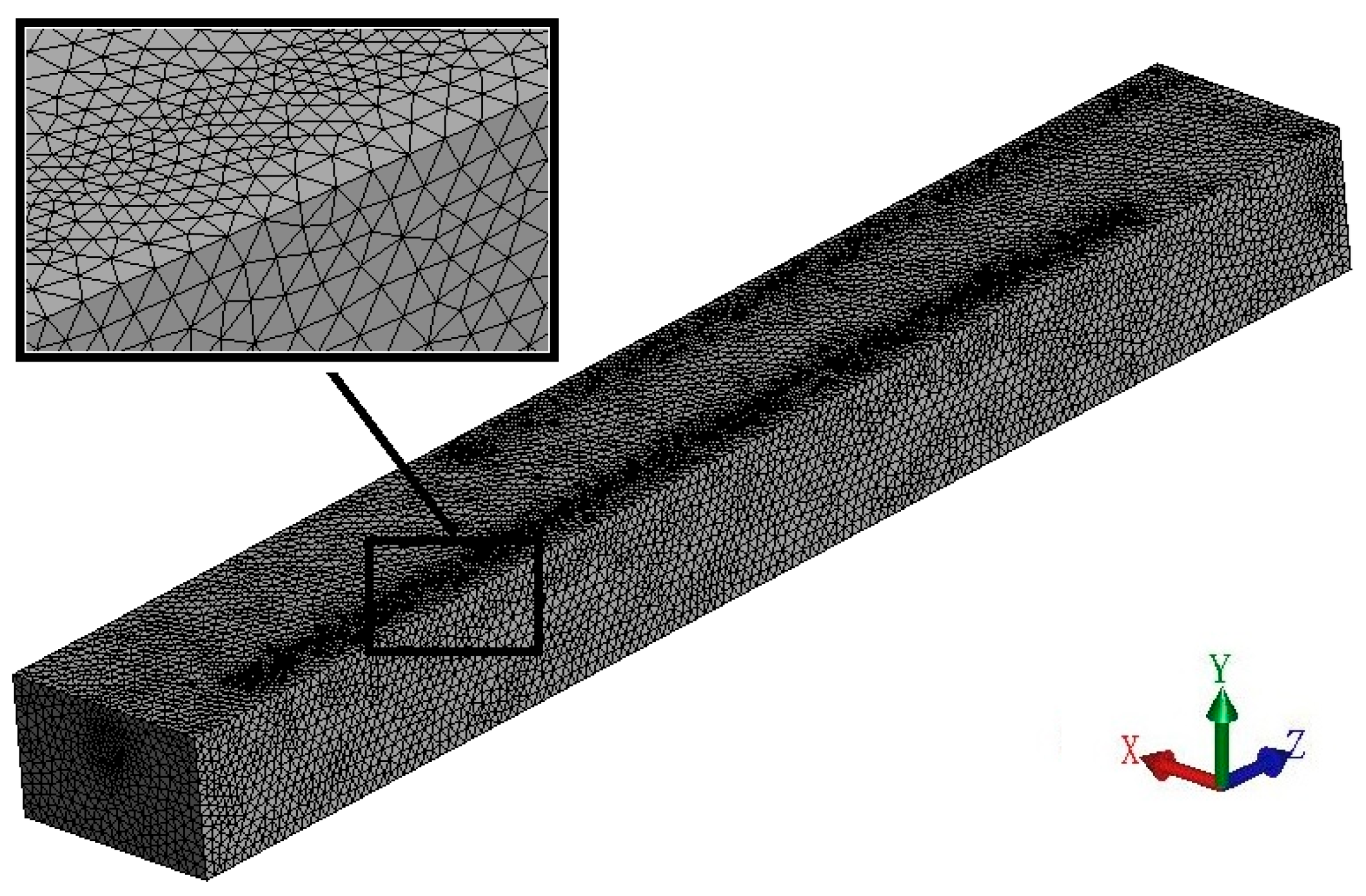




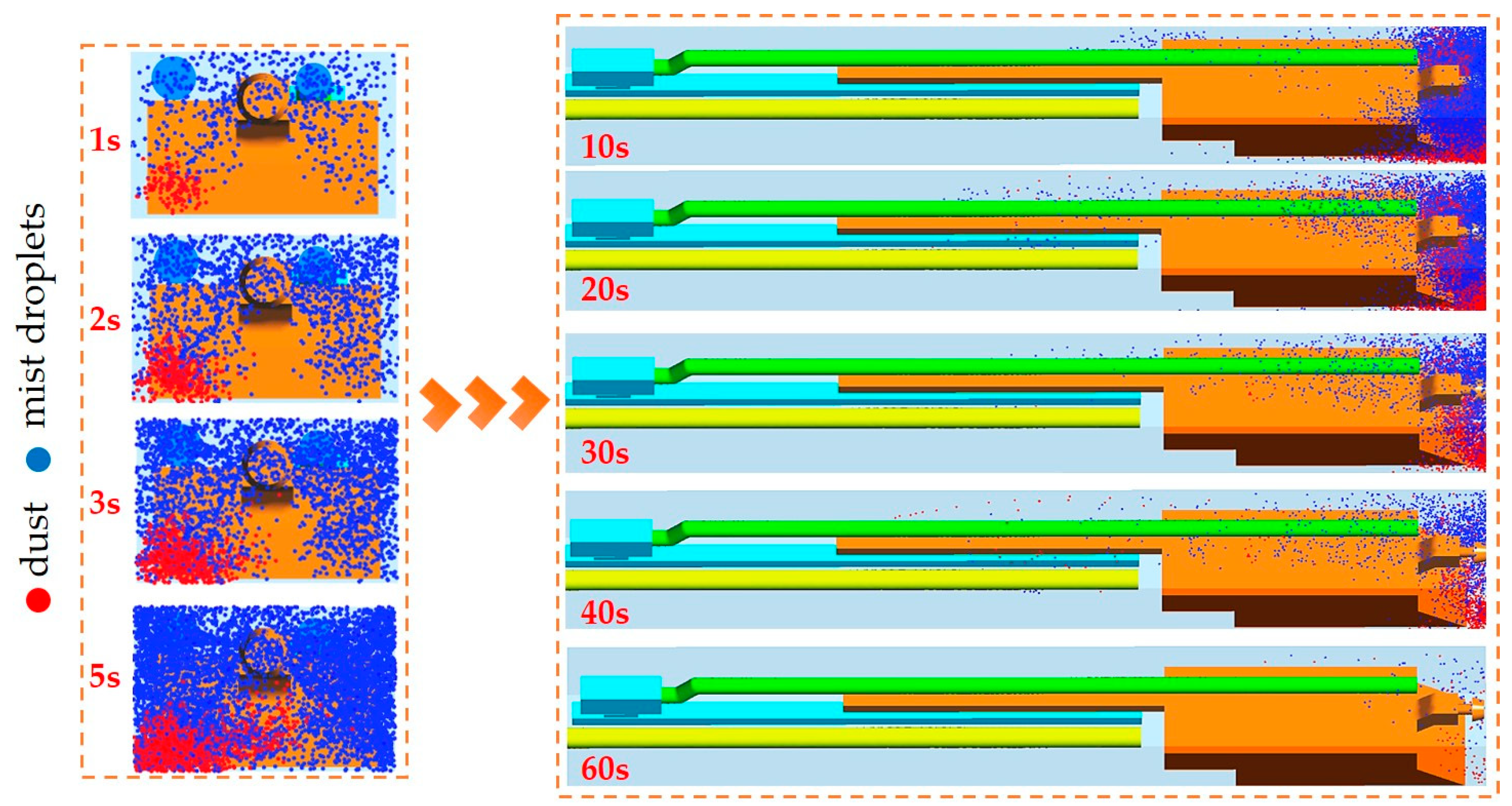
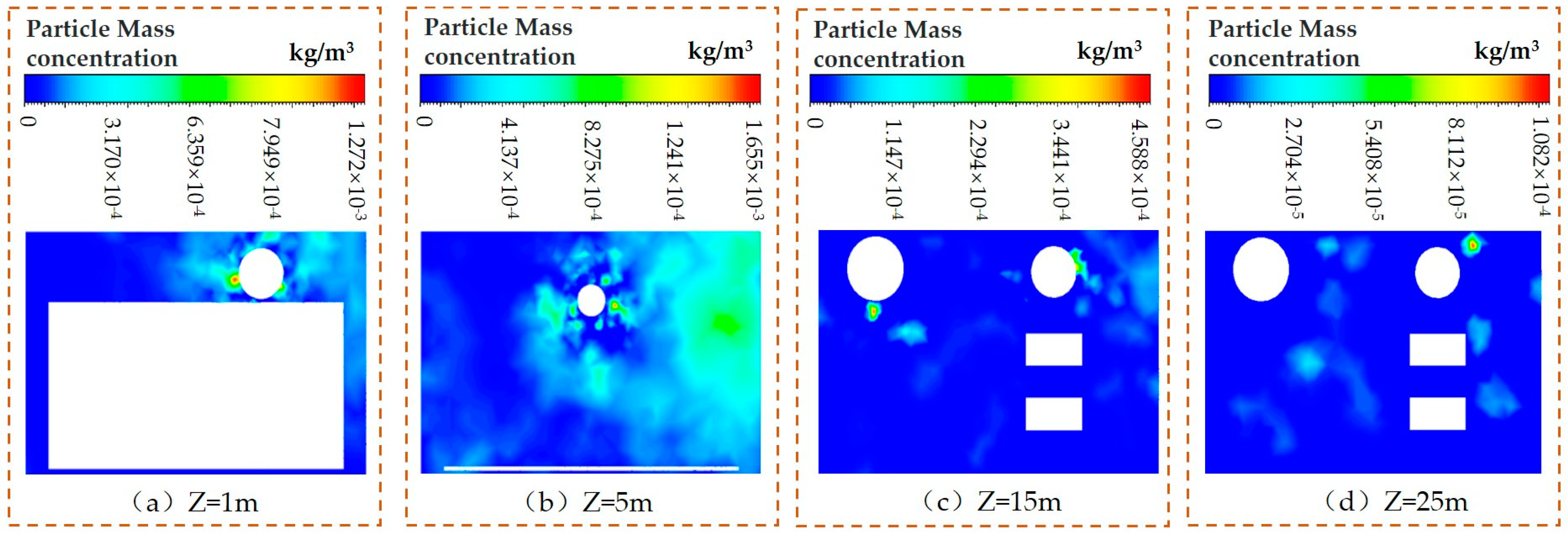
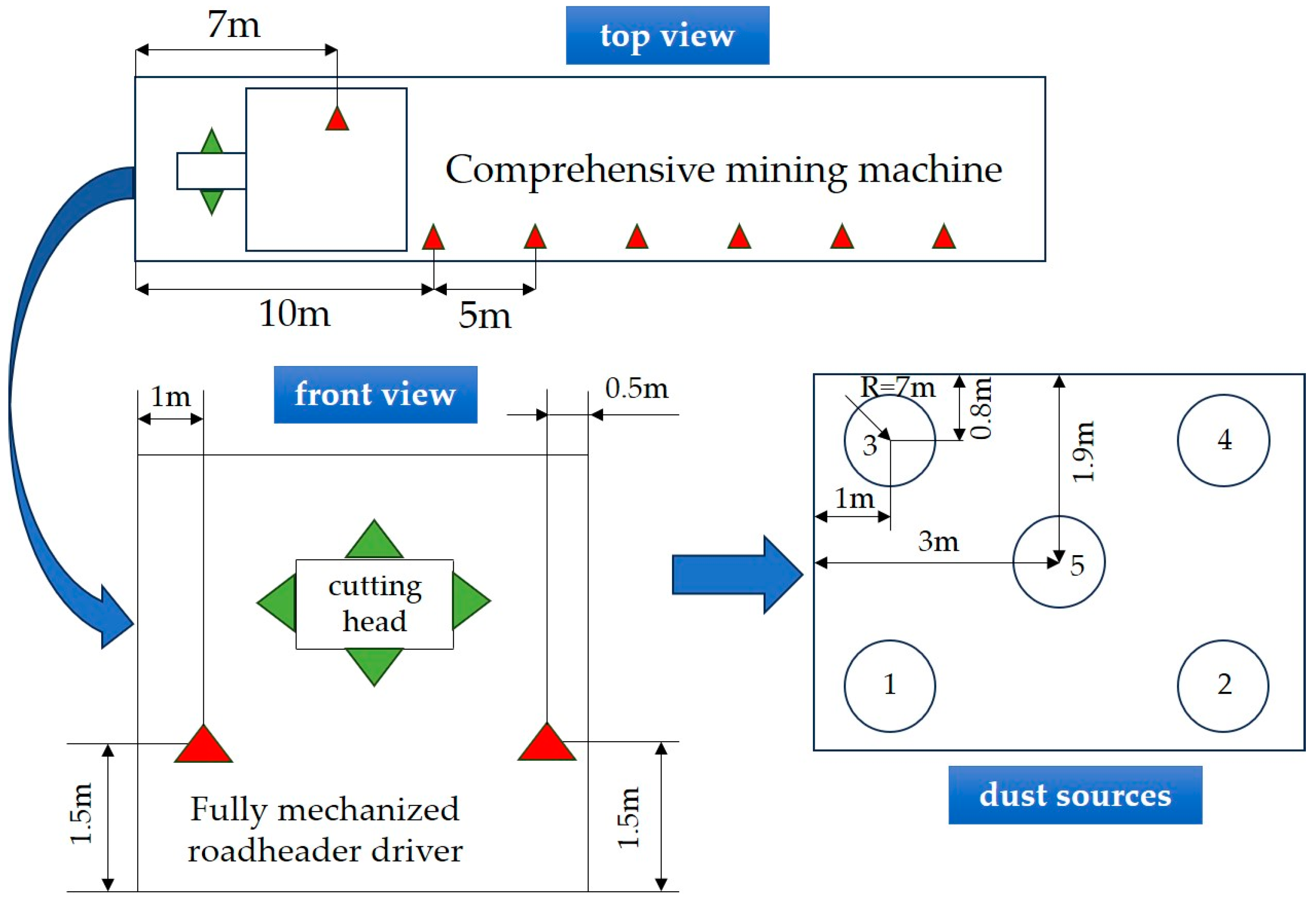
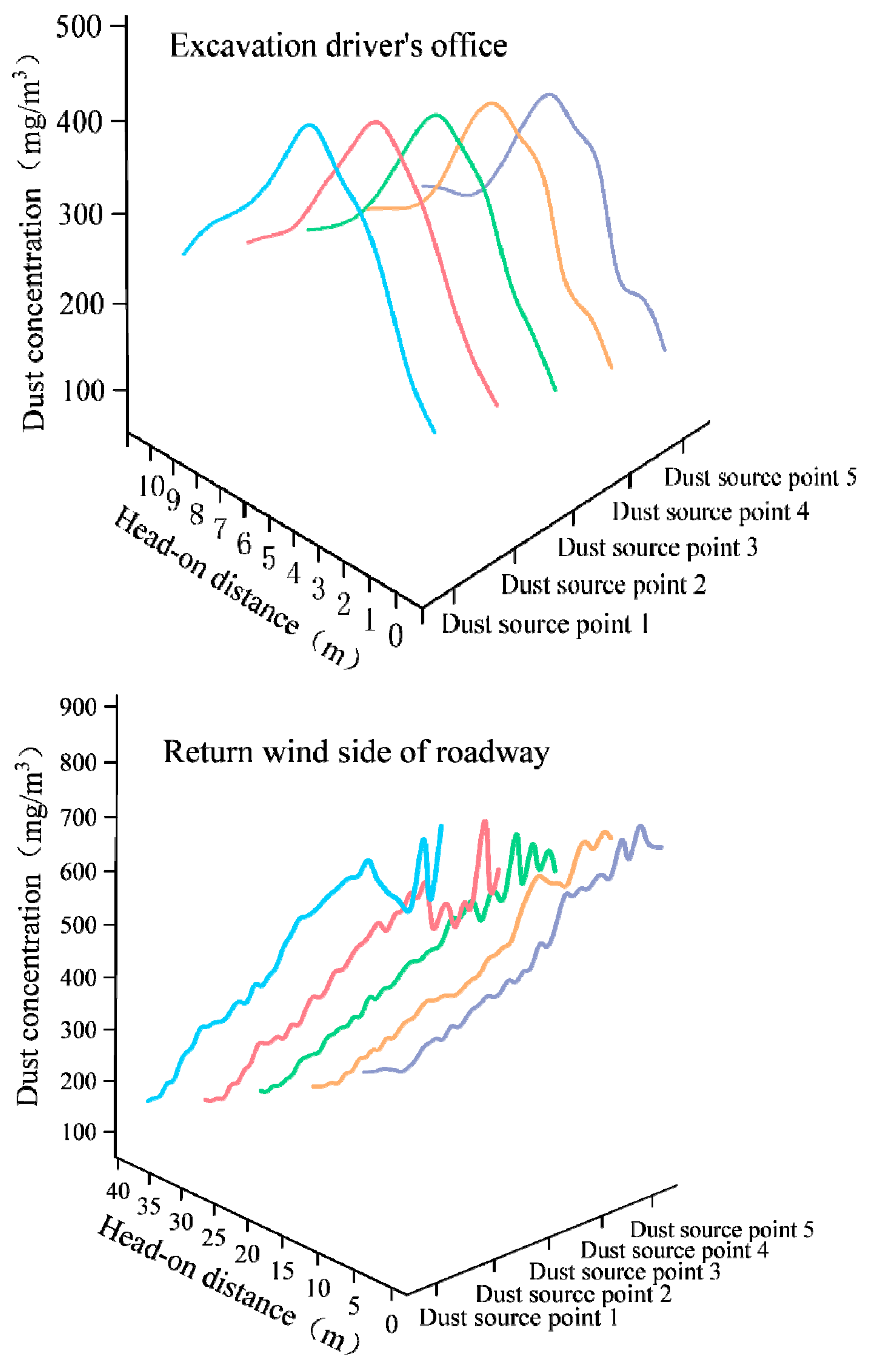
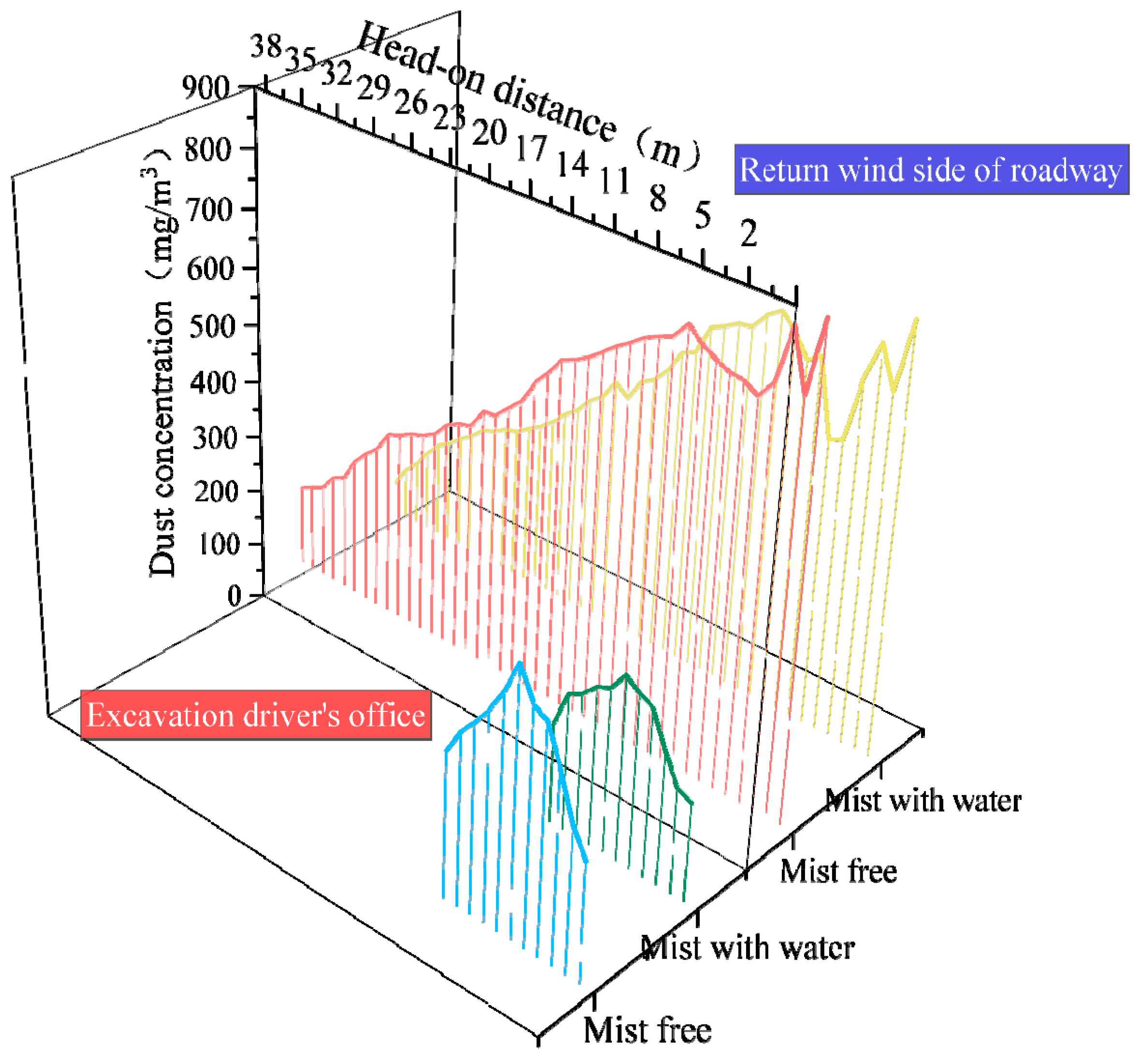
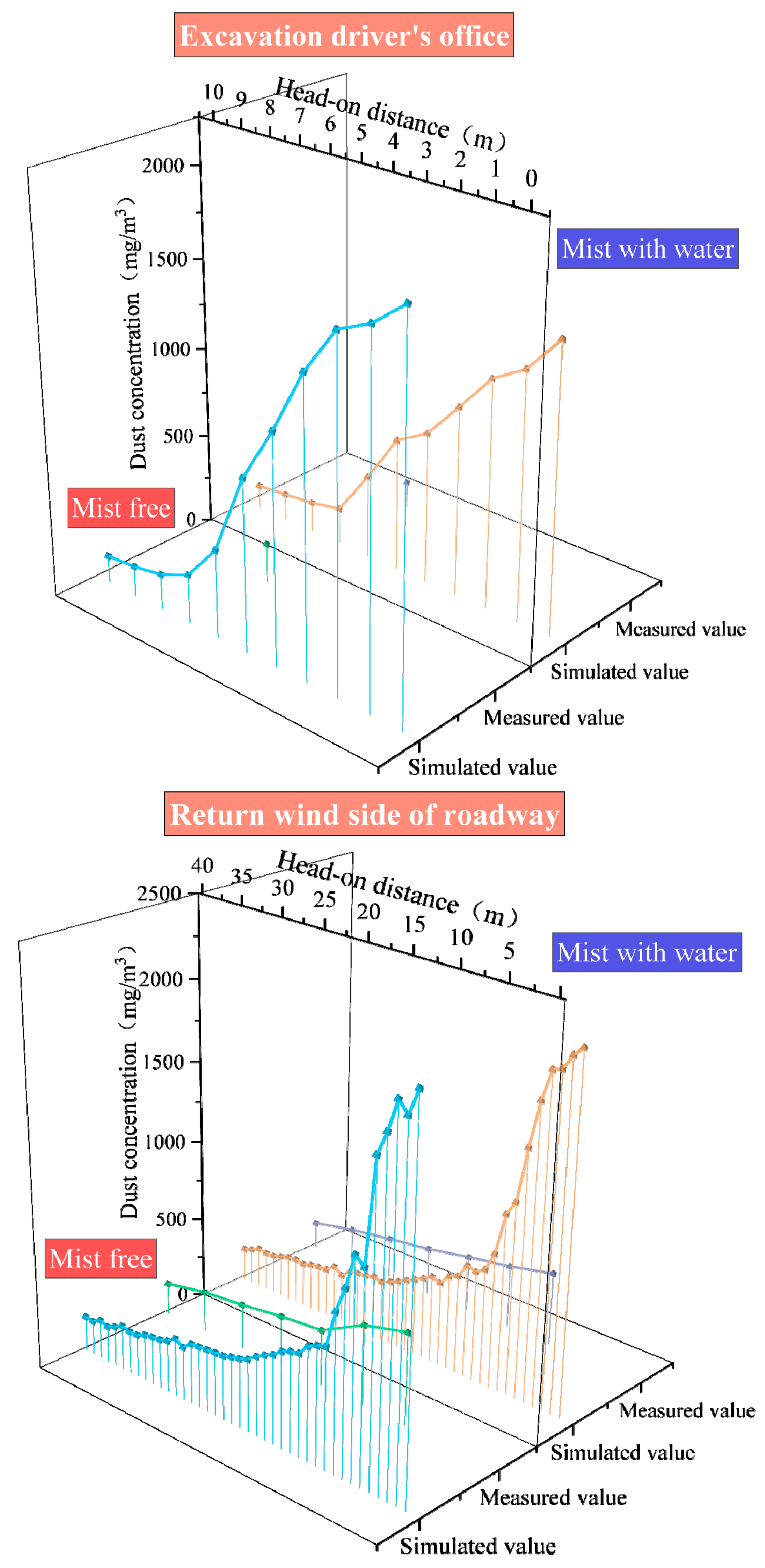
| Discrete Phase Model | Define |
|---|---|
| Drag law | Spherical |
| Injection type | Surface |
| Material | Coal-hv |
| Diameter distribution | Rosin–Rammler |
| Min. diameter | 1 × 10−6 m |
| Max. diameter | 1 × 10−4 m |
| Mean diameter | 1 × 10−5 m |
| Velocity | 10 m/s |
| Spread parameter | 1.46 |
| Total flow rate | 0.01 kg/s |
| Turbulent dispersion | Discrete random walk model |
| Injection | Define |
|---|---|
| Injection type | Pressure-swirl-atomizer |
| Density | 998.2 kg/m3 |
| Flow rate | 0.268 kg/s |
| Injector inner diameter | 0.002 m |
| Spray angle | 30° |
| Upstream pressure | 1 MPa |
| Number of streams | 100 |
Disclaimer/Publisher’s Note: The statements, opinions and data contained in all publications are solely those of the individual author(s) and contributor(s) and not of MDPI and/or the editor(s). MDPI and/or the editor(s) disclaim responsibility for any injury to people or property resulting from any ideas, methods, instructions or products referred to in the content. |
© 2024 by the authors. Licensee MDPI, Basel, Switzerland. This article is an open access article distributed under the terms and conditions of the Creative Commons Attribution (CC BY) license (https://creativecommons.org/licenses/by/4.0/).
Share and Cite
Wang, J.; Wang, B.; Gai, J. Numerical Simulation Study of Gas–Liquid–Solid Triphase Coupling in Fully Mechanized Excavation Faces with Variation in Dust Source Points. Sustainability 2024, 16, 8523. https://doi.org/10.3390/su16198523
Wang J, Wang B, Gai J. Numerical Simulation Study of Gas–Liquid–Solid Triphase Coupling in Fully Mechanized Excavation Faces with Variation in Dust Source Points. Sustainability. 2024; 16(19):8523. https://doi.org/10.3390/su16198523
Chicago/Turabian StyleWang, Jianguo, Bolan Wang, and Jinmeng Gai. 2024. "Numerical Simulation Study of Gas–Liquid–Solid Triphase Coupling in Fully Mechanized Excavation Faces with Variation in Dust Source Points" Sustainability 16, no. 19: 8523. https://doi.org/10.3390/su16198523






